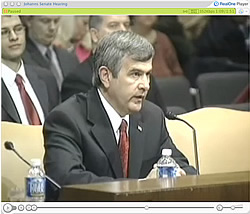USDA Officials Asked to Spread Iraq Manure
 On May 2, a U.S. Department of Agriculture speechwriter emailed 60 USDA staff that "the President has requested that all members of his cabinet and sub-cabinet incorporate message points on the Global War on Terror into speeches, including specific examples of what each agency is doing to aid the reconstruction of Iraq," reports Al Kamen. An email attachment listed "examples of GWOT messages within agriculture speeches," such as, "Several topics I'd like to talk about today -- Farm Bill, trade with Japan, WTO, avian flu ... but before I do, let me touch on a subject people always ask about ... progress in Iraq." The email said such language is "being used by [USDA] Secretary Johanns and deputy secretary Conner in all of their remarks," and urged recipients to "use these message points as often as possible" and report back when they do, for "a weekly account sent to the White House."
On May 2, a U.S. Department of Agriculture speechwriter emailed 60 USDA staff that "the President has requested that all members of his cabinet and sub-cabinet incorporate message points on the Global War on Terror into speeches, including specific examples of what each agency is doing to aid the reconstruction of Iraq," reports Al Kamen. An email attachment listed "examples of GWOT messages within agriculture speeches," such as, "Several topics I'd like to talk about today -- Farm Bill, trade with Japan, WTO, avian flu ... but before I do, let me touch on a subject people always ask about ... progress in Iraq." The email said such language is "being used by [USDA] Secretary Johanns and deputy secretary Conner in all of their remarks," and urged recipients to "use these message points as often as possible" and report back when they do, for "a weekly account sent to the White House."
- 3303 reads
 Printer-friendly version
Printer-friendly version- Add new comment
- permalink





Comments
re-USDA Officials Asked to Spread Iraq Manure
##################### Bovine Spongiform Encephalopathy #####################
Waste Reduction by Waste Reduction, Inc.
2910-D Fortune Circle West
Indianapolis, IN 46241
Phone: 317.484.4200
Fax: 317.484.4201
www.wr2.net
Comments on FDA Proposed Rulemaking - Docket No. 2002N-0273
From a public health standpoint, we are surprised and concerned that the
FDA would consider disposal of the brain and spinal cord of cattle over 30
months of age, the material it considers the highest risk SRM, through
landfill or incineration (page 44). It has been well demonstrated that there
is no reduction in potential infectivity of BSE contaminated material sent
to
landfill. Incineration of animal material is an extremely inefficient
process;
animal tissues do not make good fuel being 65% to 70% water. Further,
without specifying the conditions of temperature, residence time, and
agitation, there is no control over the efficiency of the proposed
incineration.
The work of Paul Brown at NIH has clearly shown that the infectivity of
prions (in that case 256K scrapie agent) could survive a temperature of
600ºC for 15 minutes, conditions virtually never reached in routine
incinerators. Alkaline hydrolysis at elevated temperature* has been
demonstrated to destroy infectivity even of the most virulent strain of BSE.
i.e., 301V mouse –passaged BSE, and has been included in EU legislation
as a disposal method for all Category 1 material, including known
BSEcontaminated
material.
We agree strongly with FDA’s concerns about cross contamination, not only
between ruminant feed processing lines and SRM destruction lines but also
between clean ruminant feed made from fresh animal and plant material
and ruminant feed contaminated with chicken droppings, non-ruminant feed
that could contain SRM, blood, and other waste products. While the
infectious dose quoted in Reference 13, 0.01gram of brain tissue from a
BSE infected animal, is frightening enough, a report that appeared after the
publication of the proposed rulemaking suggests that the actual infectious
dose may be as little as one-tenth that amount. While these possible
routes of infection of cattle are of serious concern, a potentially more
direct
route of infection of humans has not been adequately considered or
discussed in connection with the banning of SRM from animal feed. It is an
unfortunate fact in this country that many poor people derive their major
protein intake from the eating of pet foods. Thus, the possible inclusion of
SRM in those products could pose a direct threat to human health. The
eating of pet foods by poor people was one of the primary reasons for the
banning from pet foods of material derived from animals euthanized with
barbiturates. SRMs included in per food could pose a similar significant
threat.
We are also uncomfortable with the elimination of the small intestine of
cattle younger than 30 months of age as SRM. Absorption in the small
intestine is the primary route of infection for the prions that cause Bovine
Spongiform Encephalopathy and it has been demonstrated that these
Waste Reduction by Waste Reduction, Inc.
* In the spirit of full disclosure, it must be noted that WR2 is the
developer of the Alkaline Hydrolysis
Process and the manufacturer of Tissue Digestors™ for the use of the
Process.
agents can localize and reproduce in the lymph nodes of the intestine
before they travel to the central nervous system. For that reason, we
believe that the small intestine of all cattle, or, at least, the terminal
ileum of
all cattle, even those younger than 30 months of age, should be designated
as SRM and removed from the human and animal food chains. While we
realize that this would significantly increase the amount of SRM that
needed to be destroyed, we also believe that the necessary infrastructure
for that destruction, using scaled-up versions of current alkaline
hydrolysis
technology, could rapidly be deployed either as fixed-base plants or as
large-scale mobile systems. While some of the numbers quoted in the
discussion section of the proposed rulemaking for the amount of SRM to be
generated seem very large, efficient use of as few as 100 alkaline
hydrolysis systems capable of processing 20,000 pounds per cycle and as
few as only three cycles per day could process the 2 billion pounds per year
reported on page 25 of the proposed rulemaking.
We must also question the cost estimates for disposal made by ERG. No
specific estimate for any of the proposed disposal methods is presented;
rather, a lump sum “low-end” estimate is given with no relation to any
method. We do not know how they derived any figures on the cost of
alkaline hydrolysis for their analysis as they did not contact us or, to the
best of our knowledge, any of the sites currently using large volume Tissue
Digestors™. Operating costs for these Digestors (not including labor and
amortization of capital equipment) range between $2.5 per 100 lbs and $4
per 100 lbs, far less than the $12 average cited. Further, considering that
the ERG survey had to have been made some months before the
publication of the proposed rulemaking, it could not have taken into account
the dramatic increase in natural gas costs to fuel the proposed incinerator
disposal pathway. Thus, even the apparently high estimates presented that
must include this as, perhaps, the primary disposal pathway are probably
much too low under present circumstances.
In summary, although we accept that the proposed rulemaking may be an
improvement over the present unregulated situation with regard to the use
of SRM in animal feeds, we do not believe it is inclusive enough nor goes
far enough. We believe the original proposal from FDA would provide
significantly greater protection of public health than the currently
proposed
regulation.
http://www.fda.gov/OHRMS/DOCKETS/dockets/02n0273/02n-0273-EC232-Attach-1.pdf
tss
----- Original Message -----
From: "Terry S. Singeltary Sr."
To:
Sent: Monday, May 01, 2006 5:01 PM
Subject: Medical Waste and CJD 2003 guidelines CDC
##################### Bovine Spongiform Encephalopathy
#####################
Medical Waste and CJD 2003 guidelines CDC ?
Mon May 1, 2006 16:56
71.248.145.247
Managing Fluid Disposal
Part I of II
By Kathy Dix
Operating room (OR) personnel are frequently overwhelmed by their numerous
responsibilities of not only “fixing” the patient, but also preventing
infection, maintaining a sterile field, utilizing only sterile instruments,
and in general, ensuring the patient’s safety, as well as that of the OR
staff. Proper fluid management is one of those crucial steps to preserving
the wellbeing of both staff and patient.
Has your OR personnel been trained in the disposal of liquid waste? Are they
aware of state and/or city regulations? Is their bloodborne pathogen
training recent? Is annual competency testing required?
snip...
Of special interest, APIC’s guidelines also point out the more recent
anxiety related to Creutzfeldt-Jakob disease (CJD). “Concerns also have been
raised about the need for special handling and treatment procedures for
wastes generated during the care of patients with CJD or other transmissible
spongiform encephalopathies (TSEs),” the guidelines observe. “Prions, the
agents that cause TSEs, have significant resistance to inactivation by a
variety of physical, chemical, or gaseous methods. No epidemiologic
evidence, however, links acquisition of CJD with medical-waste disposal
practices. Although handling neurologic tissue for pathologic examination
and autopsy materials with care, using barrier precautions, and following
specific procedures for the autopsy are prudent measures, employing
extraordinary measures once the materials are discarded is unnecessary.
Regulated medical wastes generated during the care of the CJD patient can be
managed using the same strategies as wastes generated during the care of
other patients. After decontamination, these wastes may then be disposed in
a sanitary landfill or discharged to the sanitary sewer, as appropriate.”1
http://www.infectioncontroltoday.com/articles/651feat3.html
Guidelines for Environmental Infection Control
in Health-Care Facilities
Recommendations of CDC and the Healthcare Infection Control
Practices Advisory Committee (HICPAC)
U.S. Department of Health and Human Services
Centers for Disease Control and Prevention (CDC)
Atlanta, GA 30333
2003
snip...
6. Medical Waste and CJD
Concerns also have been raised about the need for special handling and
treatment procedures for wastes
generated during the care of patients with CJD or other transmissible
spongiform encephalopathies
(TSEs). Prions, the agents that cause TSEs, have significant resistance to
inactivation by a variety of
physical, chemical, or gaseous methods.1427 No epidemiologic evidence,
however, links acquisition of
CJD with medical-waste disposal practices. Although handling neurologic
tissue for pathologic
examination and autopsy materials with care, using barrier precautions, and
following specific
117
procedures for the autopsy are prudent measures,1197 employing extraordinary
measures once the
materials are discarded is unnecessary. Regulated medical wastes generated
during the care of the CJD
patient can be managed using the same strategies as wastes generated during
the care of other patients.
After decontamination, these wastes may then be disposed in a sanitary
landfill or discharged to the
sanitary sewer, as appropriate. .........
snip...
http://www.apic.org/AM/Template.cfm?Section=Search§ion=CDC1&template=/CM/Con
tentDisplay.cfm&ContentFileID=342
VARIANT CREUTZFELDT-JAKOB DISEASE (vCJD) and BLOOD
COMPONENTS
INFORMATION FOR PATIENTS, February 2006
http://www.hpa.org.uk/infections/topics_az/cjd/BC-InfoforP.pdf
http://www.hpa.org.uk/infections/topics_az/cjd/frameworkannex1-Aug2005.pdf
© 2006 American Society for Investigative Pathology
Detection and Localization of PrPSc in the Skeletal Muscle of Patients with
Variant, Iatrogenic, and Sporadic Forms of Creutzfeldt-Jakob Disease
Alexander H. Peden, Diane L. Ritchie, Mark W. Head and James W. Ironside
From the National Creutzfeldt-Jakob Disease Surveillance Unit and Division
of Pathology, School of Molecular and Clinical Medicine, University of
Edinburgh, Western General Hospital, Edinburgh, United Kingdom
Variant Creutzfeldt-Jakob disease (vCJD) differs from other human prion
diseases in that the pathogenic prion protein PrPSc can be detected to a
greater extent at extraneuronal sites throughout the body, principally
within lymphoid tissues. However, a recent study using a high-sensitivity
Western blotting technique revealed low levels of PrPSc in skeletal muscle
from a quarter of Swiss patients with sporadic CJD (sCJD). This posed the
question of whether PrPSc in muscle could also be detected in vCJD, sCJD,
and iatrogenic (iCJD) patients from other populations. Therefore, we have
used the same high-sensitivity Western blotting technique, in combination
with paraffin-embedded tissue blotting, to screen for PrPSc in muscle tissue
specimens taken at autopsy from 49 CJD patients in the United Kingdom. These
techniques identified muscle PrPSc in 8 of 17 vCJD, 7 of 26 sCJD, and 2 of 5
iCJD patients. Paraffin-embedded tissue blotting analysis showed PrPSc in
skeletal muscle in localized anatomical structures that had the
morphological and immunohistochemical characteristics of nerve fibers. The
detection of PrPSc in muscle tissue from all forms of CJD indicates the
possible presence of infectivity in these tissues, suggesting important
implications for assessing the potential risk of iatrogenic spread via
contaminated surgical instruments.
http://ajp.amjpathol.org/cgi/content/abstract/168/3/927
SEAC 2006
21. Dr Matthews noted that data are now available on the infectivity of
a wide range of bovine tissues. In September 2005, the World
Health Organisation had updated its assessment of the risk of TSE
infectivity in tissues. These data, although incomplete, should
increase confidence in the safety of particular tissues, particularly if
the age of the source animal is also considered. As a result, less
reliance need now be placed on the status of the country of origin.
Members agreed, but noted that it would be important to assess
the quality of the data on which assessments are based. As it
seems highly likely that blood, at least from humans infected with
vCJD, can be infectious, tissues and organs with a significant
blood supply may also confer higher risk.
http://www.seac.gov.uk/minutes/draft-91.pdf
THE ENVIRONMENTAL RISK FACTORS FOR TSE ARE STILL UNKNOWN, but from recent
science coming out lately, the risk factor seems to be increasing, rather
than decreasing.
CAN SOMEONE PLEASE EXPLAIN TO ME WHY IT IS STILL ACCEPTABLE FOR sanitary
landfill or discharged to the sanitary sewer, as appropriate FOR CJD, when
the epidemiology of all phenotypes of sporadic CJDs are not known to date,
and with apparent new ones of 'unknown' origin being documented as we
speak???
http://www.cjdsurveillance.com/resources-casereport.html
THE practice of landfilling and or the discharging to the sanitary sewer,
and or spreading to land as fertilizer of any human and or animal TSE should
be banned immediately. ...TSS
TSS
#################### https://lists.aegee.org/bse-l.html
####################
#################### https://lists.aegee.org/bse-l.html ####################